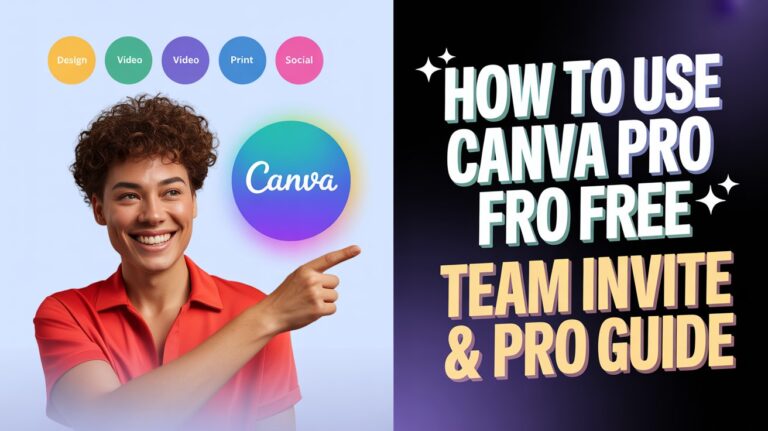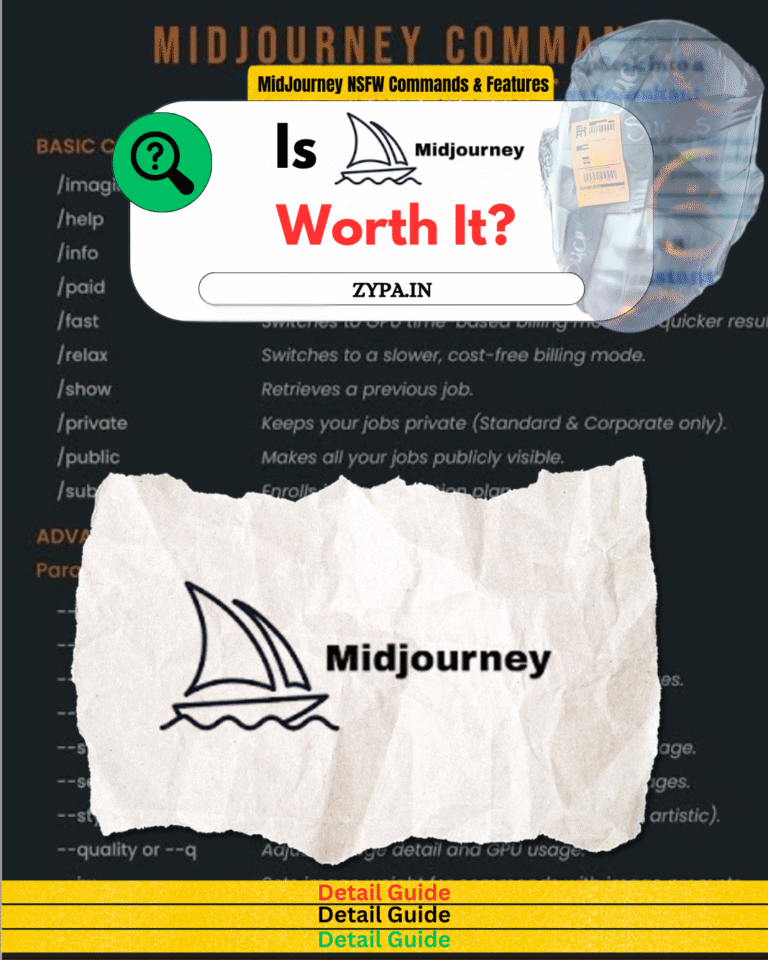Think you need money to launch a startup? Think again. Over 60% of today’s successful entrepreneurs began with less than $10,000 — and many with nothing but grit and a Google account. In this guide, you’ll learn exactly how to start a startup with $0, from finding your first million-dollar idea to building an MVP without code, validating it for free, getting your first users, and scaling smart — all without touching investor money. This isn’t fluff — it’s a step-by-step playbook for turning raw ideas into real empires with no budget, just brains.
Starting a startup with absolutely no money might sound impossible, but here’s the truth that will change everything → some of the world’s most successful companies began with nothing more than a brilliant idea and relentless determination. You don’t need a trust fund or venture capital to build your empire – you just need the right roadmap. Ready to transform your raw idea into a thriving business without spending a single dollar? Let’s dive into the step-by-step blueprint that has helped thousands of entrepreneurs build their startups from scratch.
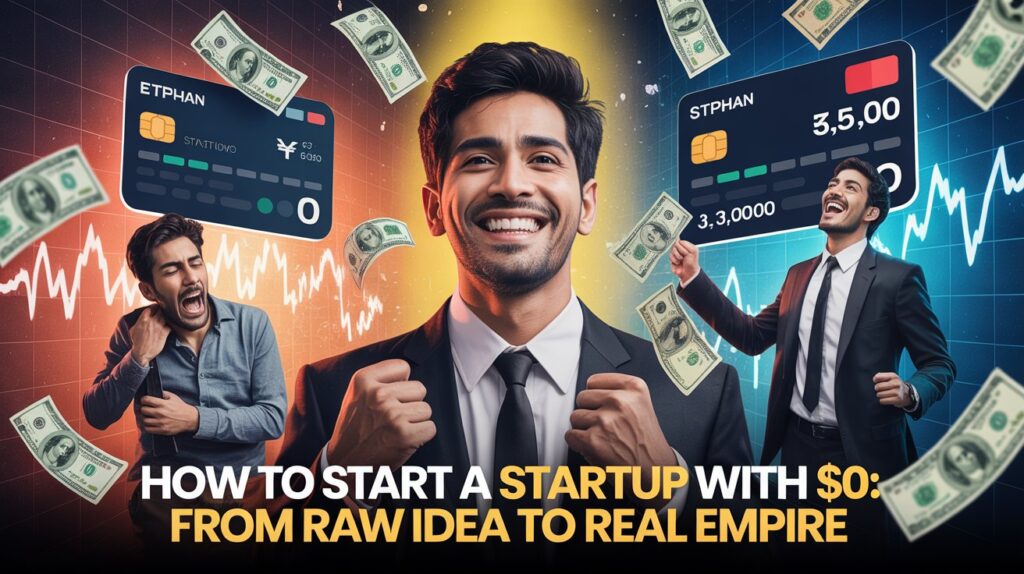
The Power of Starting with Nothing → Why $0 Can Be Your Superpower
When you start a startup with zero capital, you’re forced to become incredibly resourceful. This constraint actually becomes your competitive advantage. You’ll learn to validate ideas faster, build lean, and focus on what truly matters – solving real problems for real people. The most valuable lesson? You can’t buy your way out of poor planning or weak execution. Starting with $0 forces you to master the fundamentals that big-budget startups often skip.
How to Start a startup in Just 10 Steps
Here’s your 10 simple and powerful Steps that you can implement to build your own empire:
Step 1 → Find Your Million-Dollar Problem (The Idea Goldmine)
Your startup journey begins with identifying a problem that keeps people awake at night. The best startup ideas don’t come from brainstorming sessions – they come from frustrations you experience daily.
How to Uncover Profitable Problems
Start by looking at your own daily struggles. What tasks do you avoid? What processes feel unnecessarily complicated? What makes you think “there has to be a better way”?
Here’s a proven 3-step method:
- Problem Spotting → Spend one week documenting every minor frustration you encounter
- Passion Filter → Circle the problems related to your interests and skills
- Solution Innovation → Research existing solutions and identify gaps you could fill better
Remember, successful startups solve problems people are already trying to solve with imperfect tools or services.
Step 2 → Validate Your Idea Before Building Anything
Here’s where most aspiring entrepreneurs make their first critical mistake → they start building before confirming people actually want what they’re creating. Validation saves you months of wasted effort and prevents the heartbreak of launching something nobody needs.
Free Validation Methods That Actually Work
- Survey Your Target Audience → Create surveys using free tools like Google Forms or Typeform. Ask specific questions about pain points, current solutions, and willingness to pay.
- Social Media Testing → Post about your idea in relevant Facebook groups, Reddit communities, or LinkedIn groups. Pay attention to engagement and comments.
- One-on-One Interviews → Reach out to 10-20 potential customers for 15-minute conversations. These conversations will give you invaluable insights you can’t get from surveys.
The Pre-Selling Test
The ultimate validation method? Get people to pay before you build. Create a simple landing page describing your solution and ask for pre-orders. If people won’t pay $10 for your solution, they definitely won’t pay $100 later.
Tools you need (all free):
- Landing Page → Use Carrd or Wix (free versions)
- Payment Processing → PayPal or Stripe (no monthly fees)
- Email Collection → Mailchimp (free for up to 2,000 contacts)
Step 3 → Build Your Minimum Viable Product (MVP) for Free
Your MVP isn’t about creating a perfect product – it’s about building the simplest version that solves your core problem. Think of it as a prototype that proves your concept works.
No-Code MVP Options
You don’t need to be a programmer to build a startup anymore. Here are powerful no-code tools that won’t cost you anything:
For Apps:
- Bubble → Create complex web applications without coding
- Glide → Turn Google Sheets into mobile apps
- Adalo → Build native mobile apps with drag-and-drop
For E-commerce:
- Shopify (14-day free trial, then use earnings to pay)
- WooCommerce (completely free with WordPress)
- Gumroad (free to start, small fee per sale)
For Service Businesses:
- Calendly → Free appointment scheduling
- Google Workspace → Professional email and collaboration tools
- Canva → Professional design tools with free tier
The Lean Approach
Focus on one core feature that solves your main problem. Ignore everything else for now. Your first version should be embarrassingly simple – that’s exactly what you want.
Pro Tip → If you’re not slightly embarrassed by your first version, you waited too long to launch.
Step 4 → Master the Art of Bootstrap Funding
Bootstrapping means funding your startup through creative methods that don’t require external investment. It’s about maximizing impact while minimizing expense.
Revenue-First Strategies
- Pre-Selling → Sell your product before you build it. Offer early-bird pricing to generate initial revenue.
- Service-to-Product Pipeline → Start with consulting or services in your field, then use profits to fund product development.
- Affiliate Marketing → Promote relevant products to your audience while building your own solution.
Free Resources That Replace Expensive Tools
- Instead of expensive project management software → Use Trello or Asana (free tiers)
- Instead of paid design software → Use Canva or GIMP (completely free)
- Instead of expensive analytics → Use Google Analytics (free and powerful)
- Instead of paid hosting → Start with free tiers from Netlify or Vercel
Step 5 → Build Your Online Presence (Your Digital Empire Foundation)
Your online presence is your startup’s foundation. In today’s digital world, if you don’t exist online, you don’t exist at all.
Choose Your Startup Name Strategically
Your name should be:
- Easy to spell and pronounce
- Available as a .com domain
- Not trademarked by someone else
- Memorable and relevant to your industry
Free Name Generation Tools:
- Namelix → AI-powered name generator – namelix.com
- Shopify Business Name Generator → Business Name Generator
- Lean Domain Search → leandomainsearch.com
Check Global Name Availability
Before locking in your startup name, make sure it’s not already taken or legally protected elsewhere. Here’s how to do a quick global check:
- Search for registered companies: Use platforms like Crunchbase to see if any startups worldwide are already using your desired name.
- Check domain name availability: Tools like GoDaddy or Namecheap will help you find if the .com or other relevant domains are available for your brand.
- Look for existing trademarks: Use WIPO Global Brand Database or your country’s trademark site (like USPTO or IP India) to ensure no one has legally claimed the name.
- Social media availability: Use Namechk to instantly check if your brand name is free across major platforms like Instagram, YouTube, and Twitter.
Pro Tip: A great startup name is one that’s unique across the internet — domain, social handles, and legal records. Do this research once, and save yourself legal trouble later.
Secure Your Domain and Online Identity
Best Domain Registrars:
- Namecheap → Often cheapest, excellent customer service – namecheap.com
- Cloudflare → Great pricing and built-in CDN – cloudflare.com
- GoDaddy → Most popular, frequent sales – godaddy.com
Immediately secure your social media handles across all major platforms, even if you won’t use them initially.
Build Your Website Without Breaking the Bank
Free Website Builders:
- Wix → Drag-and-drop builder with free tier – wix.com
- WordPress.com → Free hosting with WordPress branding – wordpress.com
- Google Sites → Simple and free – sites.google.com
Your website needs these essential pages:
- Home page explaining your solution
- About page building trust
- Contact information
- Simple landing page for lead capture

Step 6 → Legal Setup (Protecting Your Future Empire)
You can’t afford to skip legal basics, but you also can’t afford expensive lawyers yet. Here’s how to handle essential legal requirements on a budget.
Choose Your Business Structure
- Sole Proprietorship → Simplest option, no formal registration required, but offers no liability protection.
- LLC → Best balance of simplicity and protection. Costs vary by state ($50-$500 filing fee).
- Corporation → More complex but preferred by investors. Consider this if you plan to raise funding later.
Free Legal Resources:
- LegalZoom → Affordable business formation – legalzoom.com
- SCORE → Free business mentoring – score.org
- Small Business Administration → Extensive free resources – sba.gov
Protect Your Intellectual Property
File for trademarks and patents only after validating your idea and generating revenue. Initially, focus on:
- Securing domain names
- Creating terms of service (use free templates)
- Establishing basic privacy policies
Step 7 → Growth Hacking on a Zero Budget
Traditional marketing requires significant budgets. Growth hacking uses creativity and analytics instead of money to achieve explosive growth.
Content Marketing That Actually Works
- Blog Strategy → Start a blog addressing your target audience’s problems. Use free platforms like Medium or WordPress.com initially.
- Video Content → Create helpful videos using your smartphone and free editing software like DaVinci Resolve.
- Podcast Appearances → Instead of starting your own podcast, appear as a guest on existing shows in your industry.
Social Media Domination
Focus on 1-2 platforms where your audience spends time:
- LinkedIn → Perfect for B2B startups
- Instagram → Visual products and younger demographics
- Twitter → Tech startups and thought leadership
- TikTok → Consumer products and Gen Z audiences
Engagement Strategy → Spend 30 minutes daily commenting meaningfully on posts from your target audience. Provide value, don’t sell.
Community Building
- Join Existing Communities → Participate in Facebook groups, Reddit communities, Discord servers, and industry forums.
- Create Your Own Community → Start a Facebook group or Slack community around your industry’s problems.
Email Marketing
Email remains the highest ROI marketing channel. Start collecting emails from day one using:
- Mailchimp → Free up to 2,000 contacts
- ConvertKit → Free tier for creators
- Substack → Free newsletter platform
Step 8 → List Your Startup Everywhere (Maximum Exposure, Zero Cost)
Getting your startup discovered requires strategic placement across the internet. Here are the essential directories and platforms where you should list your startup:
Essential Startup Directories
Major Startup Platforms:
- Product Hunt → producthunt.com – Perfect for launching new products
- Crunchbase → crunchbase.com – Essential for startup credibility
- AngelList (Wellfound) → wellfound.com – Connect with investors and talent
- BetaList → betalist.com – Great for pre-launch startups
- Startup Ranking → startupranking.com – Global startup directory
Industry-Specific Directories:
- G2 → g2.com – Software reviews and listings
- Capterra → capterra.com – Business software directory
- Software Advice → softwareadvice.com – Software comparison site
- F6S → f6s.com – Startup community and funding opportunities
Local and Niche Listings
Don’t forget location-based listings:
- Google My Business → Free and essential for local visibility
- Yelp → Important for service-based businesses
- LinkedIn Company Page → Professional presence
- Local chamber of commerce directories
Pro Tip → Create a spreadsheet to track where you’ve submitted your startup and follow up on pending applications.
Step 9 → Network Like Your Success Depends on It (Because It Does)
Networking isn’t about collecting business cards – it’s about building genuine relationships that create opportunities.
Strategic Networking Approaches
- Industry Events → Look for free startup events, meetups, and conferences in your city. Many offer virtual options too.
- Online Communities → Join startup-focused groups on:
- Indie Hackers → indiehackers.com
- Reddit → r/entrepreneur, r/startups
- Discord → Various startup communities
- Clubhouse → Join startup-related rooms
- Mentorship Programs → Connect with experienced entrepreneurs through:
- SCORE → score.org – Free business mentoring
- MicroMentor → micromentor.org – Free mentorship matching
- ADPList → adplist.org – Free career mentorship
Building Your Advisory Board
Identify 3-5 successful individuals who could provide guidance. Offer equity in exchange for their expertise and network access. Most advisors accept 0.25-1% equity for early-stage involvement.
Step 10 → Scale Without Losing Your Mind (Or Your Money)
Scaling too fast kills more startups than growing too slowly. Focus on sustainable growth that doesn’t compromise quality or burn through resources.
Key Metrics to Track
- Customer Acquisition Cost (CAC) → How much you spend to acquire each customer
- Lifetime Value (LTV) → How much revenue each customer generates over time
- Monthly Recurring Revenue (MRR) → Predictable monthly income
- Churn Rate → Percentage of customers who stop using your product
Use free analytics tools:
- Google Analytics → Website traffic and behavior
- Mixpanel → Product usage analytics (free tier)
- Hotjar → User behavior tracking (free tier)
When to Consider Funding
Only pursue external funding when:
- You’ve proven product-market fit
- You have consistent revenue growth
- You need capital to scale faster than bootstrapping allows
- You’ve identified specific growth opportunities requiring investment
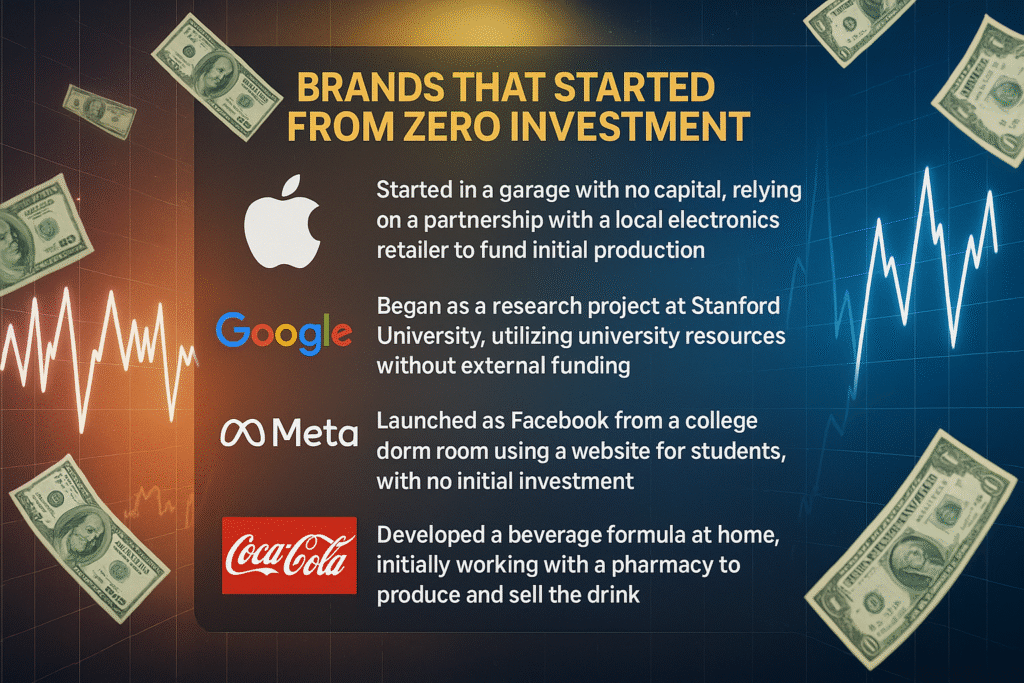
Websites to Discover Problems Worth Solving:
- Reddit
- 🔍 Subreddits like r/Entrepreneur, r/Startups, r/SaaS, r/IndiaStartups
- Read what real people are struggling with — goldmine of problems.
- Indie Hackers
- Real solo founders sharing what they’re building and what problem they’re solving.
- 💡 Read interviews + comment sections = pain points + market gaps.
- Answer the Public
- Type a keyword, and it shows what questions people are asking online.
- Great to discover hidden needs in any niche.
- Exploding Topics
- Shows rising problems, searches, and topics BEFORE they go mainstream.
- Use it to catch problems early and build smart.
- Twitter/X Advanced Search
- Search phrases like “I wish there was an app for…” or “I hate when…”
- 💣 You’ll find real frustrations → startup gold.
- Quora
- Type in your niche and read what problems people are asking help for.
- Answer = build a product or service around it.
- Google Trends
- See which industries and topics are getting hot — explore the gaps in solutions.
- Y Combinator Startup Ideas
- YC has a public list of unsolved or under-solved problems.
- 🔥 These are problems top investors want startups to solve.
BONUS HACK: Go to YouTube Comments on viral videos related to finance, productivity, freelancing, AI, etc. — People say “I need this” / “Why isn’t this a thing?” = perfect problem to build on.
Best Websites to Check If Your Startup Will Work
- Google Trends
- Check if people are actively searching for your idea.
- Use it to validate demand and popularity trends over time.
- Exploding Topics
- Find startup ideas that are growing fast but still early stage.
- Great for riding upcoming waves.
- Product Hunt
- Search your idea here — is something similar already launched?
- If yes, check engagement and feedback. If no, maybe you’re early!
- SurveyMonkey / Typeform
- Make a simple validation survey and share it with your target users.
- Super helpful to get real opinions before building.
- Kickstarter / Indiegogo
- These are crowdfunding platforms — if people back similar ideas here, it’s a green signal.
- Proof of concept + real pre-sales.
- Google Keyword Planner
- See if people are searching (and advertisers bidding) for keywords related to your startup idea.
- If keywords have high volume + competition, it means the market is hot!
- Y Combinator’s Startup Library
- Goldmine of frameworks to check if your idea is strong or weak.
- Search for “Idea Validation” and “Product-Market Fit.”
Bonus 🔧 Tool: Validation Board by Lean Startup Machine — A full free tool to organize your startup hypothesis, target audience, and run quick tests to validate or pivot.
Case Studies of Brands That Used These Exact Steps
From Bedrooms to Billions → Startup Success Stories. Some of today’s biggest software titans and billion-dollar empires were literally established from bedrooms, basements, and side hustles. If you’ve been wondering how to start a startup without funds, investors, or a fancy office – you’re at the perfect spot. From Airbnb to Trello, these firms proven that solving a problem + MVP + hustle equals startup magic. Let’s break it all down in a clear, no-BS fashion.
Airbnb → Startup from a Living Room
Backstory
Two broke roommates in San Francisco, Brian Chesky and Joe Gebbia, couldn’t pay rent. A design conference was in town, and hotels were filled. So, they rented out air mattresses in their apartment. Yes, the initial Airbnb was actually “Air Bed & Breakfast.”
Their $0 Moves
- Built a basic website
- Charged $80 per night per airbed
- Validated demand fast → 3 guests booked instantly
- Turned a financial catastrophe into a billion-dollar opportunity
Startup Tip → Start with what you have. You don’t need a full-blown app. Just test your idea with real humans.
Dropbox → MVP with Just a Video
The Challenge
Drew Houston had a fantastic idea → sync data across devices. But creating it was tremendously technical. So, instead of coding, he prepared a short explanatory film.
What Happened
- Posted the video to Digg
- 5,000 beta users grew to 75,000 in 24 hours
- Didn’t write code until users indicated they wanted it
Startup Tip → You don’t need a product to validate a product. A landing page or movie can be adequate.
Use Case
Looking for websites for startup MVPs? Tools like Carrd, Webflow, and Notion are great.
Spanx → From $5K to Billionaire
The Spark
Sara Blakely hated how pantyhose looked in open-toe shoes. So, she sliced the feet off hers. That DIY hack became Spanx.
Her Hustle
- Invested $5,000 of savings
- Learned patent law herself
- Cold-called hosiery mills till one said yes
- Landed Neiman Marcus with a live product presentation in a store bathroom
Startup Tip → The best startup ideas fix your own irritating problem.
Mailchimp → Side Hustle Turned Giant
Origin
Ben Chestnut and Dan Kurzius managed a small agency. Clients wanted email marketing, but tools sucked. So, they constructed one.
The Playbook
- Started as a side project
- Used revenue from client work to support it
- Launched a free plan (freemium model)
- Let free users promote Mailchimp via email footers
Result
Explosive viral growth without ad cost.
Startup Tip → You don’t need to quit your job to launch a startup. Build while you earn.
GitHub → Built by Developers, for Developers
How It Began
Tom and Chris were bored with clumsy version control software. They hacked together GitHub over weekends.
Startup Style
- Used open-source tools
- Targeted devs (their own community)
- Built in virality → sharing code improved awareness
Result
Microsoft bought GitHub for $7.5B.
Startup Tip → Build tools your tribe genuinely needs. Know your niche deeply.
Craigslist → From Email List to Billions
The Start
In 1995, Craig Newmark only wanted to share exciting local events with friends. So, he emailed them a list.
What Changed
- People started sending his emails
- Then wanted to post their own events
- He constructed a rudimentary site with text listings
Still going strong
Craigslist is worth billions today and rarely modified its design.
Startup Tip → Simplicity prevails. Focus on function over frills.
Trello → Built in Public at TechCrunch Disrupt
The Pain Point
PM tools were too sophisticated. Joel Spolsky wanted something visual and straightforward.
Their Strategy
- Made a Kanban-style board (To Do, Doing, Done)
- Launched at TechCrunch Disrupt
- Gained enormous traction with a basic product
- Used a freemium model
Result
25M+ users. Sold to Atlassian for $425M.
Startup Tip → Your MVP should be so easy it’s almost humiliating. Launch anyway.
Patterns Every Bootstrapped Founder Should Copy
Here’s what every one of these stories teaches about how to launch tech startup projects:
1. Solve Your Own Problem
Almost all founders scratched their own itch. If something upsets you, likelihood are others feel the same.
2. Validate Early
Don’t construct a whole platform. Launch a landing page. Shoot a video. Sell before you build.
3. Start Stupid Simple
Trello had 3 columns. Airbnb has airbeds. GitHub was a weekend utility. MVP = Minimum Viable, not Maximum Fancy.
4. Bootstrap Like a Boss
Use freelancing, savings, or side work to support your startup. That way, you control the game.
5. Engineer Virality
Add viral loops → refer friends, freemium plans, shareable content, or community tools.
6. Evolve With Users
Every brand listed evolved based on consumer feedback. Airbnb updated listings. Trello introduced integrations. Mailchimp designed a whole suite.
🎉 So… What’s Your Move?
If you’re still stuck thinking “how do I start a startup with no money?” – this is your blueprint:
- Spot the pain → What’s annoying you?
- Test it fast → Video, landing page, DMs
- Sell early → Get someone to pay for the promise
- Keep it basic → Build what works
- Grow smart → Focus on users > features
Use tools like Carrd, Framer, or Notion to whip together websites for startup debuts in a day.
Remember, you don’t need to be perfect. You need to start. 🚤 Build something modest. Ship it fast. Improve it later. Your billion-dollar idea is probably sitting in your thoughts or on a notepad right now. Time to bring it to life.
Which founder’s path influenced you the most? Drop a comment and let’s get your startup started now!

Essential Tools and Websites for Startups with ZERO Budget
Here’s your comprehensive toolkit for building a startup without spending money:
Business Name Generation:
- Namelix → namelix.com – AI-powered name generation
- Lean Domain Search → leandomainsearch.com – Domain-focused names
- Shopify Name Generator → shopify.com/tools/business-name-generator
Domain Registration:
- Namecheap → namecheap.com – Affordable domains with excellent support
- Cloudflare Registrar → cloudflare.com – At-cost pricing, no markup
- Porkbun → porkbun.com – Growing reputation, competitive pricing
Website Building:
- Wix → wix.com – Drag-and-drop with free tier
- WordPress.com → wordpress.com – Powerful content management
- Carrd → carrd.co – Simple one-page sites
Startup Directories and Listings:
- Product Hunt → producthunt.com
- Crunchbase → crunchbase.com
- AngelList → wellfound.com
- BetaList → betalist.com
- Startup Buffer → startupbuffer.com
- AllTopStartups → alltopstartups.com
- F6S → f6s.com
No-Code Development:
- Bubble → bubble.io – Complex web applications
- Webflow → webflow.com – Design-focused websites
- Zapier → zapier.com – Automation and integration
Marketing and Analytics:
- Mailchimp → mailchimp.com – Email marketing
- Canva → canva.com – Design tools
- Buffer → buffer.com – Social media scheduling
- Google Analytics → analytics.google.com – Website analytics
Remember → The best tool is the one you’ll actually use consistently. Start simple and upgrade as you grow.
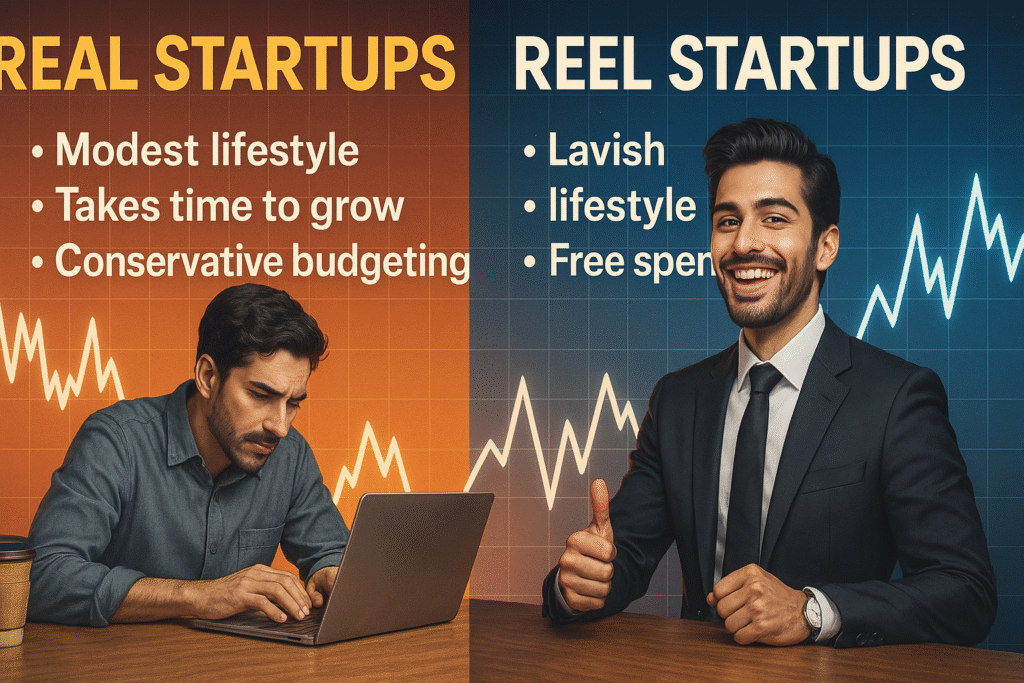
Common Pitfalls to Avoid (Learn from Others’ Expensive Mistakes)
The Perfection Trap
Many entrepreneurs spend months perfecting their product before launching. This is a costly mistake. Your first version should solve the core problem adequately – nothing more.
Solution → Set a firm launch deadline and stick to it, regardless of how “unpolished” your product feels.
Trying to Do Everything
When you’re bootstrapping, focus is everything. You can’t compete on every front, so choose your battles wisely.
Solution → Identify the one thing your startup does better than anyone else, then double down on that advantage.
Ignoring Customer Feedback
Your assumptions about what customers want are often wrong. The market will teach you what really matters.
Solution → Build feedback loops into everything you do. Survey customers, analyze usage data, and iterate quickly.
Scaling Prematurely
Growing too fast can kill your startup just as quickly as growing too slowly.
Solution → Focus on sustainable growth. Make sure your unit economics work before scaling marketing efforts.
Full Roadmap for Startup: Your 30-Day Action Plan
Ready to start? Here’s your step-by-step 30-day roadmap:
Week 1 → Idea and Validation
- Day 1-3 → Identify and research your problem
- Day 4-5 → Create validation surveys and landing page
- Day 6-7 → Conduct customer interviews
Week 2 → MVP Development
- Day 8-10 → Choose your MVP approach and tools
- Day 11-14 → Build your minimum viable product
Week 3 → Online Presence
- Day 15-17 → Register domain and build basic website
- Day 18-20 → Set up social media profiles
- Day 21 → Create business email and Google My Business listing
Week 4 → Launch and Growth
- Day 22-24 → Submit to startup directories
- Day 25-27 → Begin content marketing and networking
- Day 28-30 → Analyze initial results and plan next steps
FAQ’s About Startup
1. How do I start my startup?
Start with identifying a real problem people face → validate it → build a simple solution (MVP) → test with real users → iterate fast.
Example: Zomato began by listing menus in Delhi restaurants on a simple website.
2. Is it true that 90% of startups fail?
Yes, stats say around 90% fail, mostly due to lack of market need, poor execution, or running out of money.
Example: Google+ failed despite funding, because it didn’t solve a unique user need.
3. How much money does it take to start a startup?
Many startups begin with zero or minimal funds, using free tools and sweat equity. It depends more on execution than money.
Example: Instagram started with a small team and pivoted early with no massive investment.
4. Can I start a startup by myself?
Absolutely. Many solopreneurs build successful ventures alone, then scale with a team later.
Example: Pieter Levels launched NomadList and RemoteOK solo, earning $100K+ per month.
5. Difference between Business, Entrepreneur and Startup?
Business: Profit-focused, stable model.
Startup: Temporary setup seeking a scalable, disruptive solution.
Entrepreneur: The person behind it all, taking risks and driving the vision.
6. How to start a startup without idea?
Explore problems in your daily life or others’ frustrations. Join communities, study trends, or improve an existing solution.
Example: Canva was born from noticing how hard design tools were for non-designers.
7. How to start a startup with no money?
Use free tools, build an MVP yourself, offer services before products, or start a digital product business (like selling templates or courses).
Example: ZYPA can be scaled as a service-first platform with zero inventory costs.
Conclusion: The Million-Dollar Mindset Shift
Starting with $0 isn’t a limitation – it’s preparation for success. Every constraint forces you to become more creative, more focused, and more customer-centric. These skills become invaluable as your startup grows. The entrepreneurs who master bootstrapping often build more sustainable, profitable companies than those who raise money immediately. You’re not behind because you don’t have funding – you’re ahead because you’re learning to build efficiently.
Your next step is simple → Pick one idea, validate it this week, and start building. The world needs what you’re capable of creating, and every day you wait is another day your future customers continue struggling with the problem you could solve.
Remember, every empire started with a single brick. Your startup journey begins with taking that first step, even when – especially when – you have nothing but determination and a great idea. The path from $0 to your first $1,000, then to $10,000, and eventually to your empire isn’t just possible – it’s been traveled by thousands before you. Now it’s your turn to walk it.
Ready to start your startup journey? The only thing standing between you and your empire is action. Take that first step today.
This comprehensive guide provides everything you need to start a startup with absolutely no money. Bookmark this page, follow the action plan, and start building your empire today. Your future self will thank you for taking action now.

